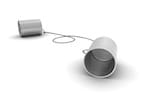Why Social Media Has Definitely Not Replaced Word-of-Mouth in Medical Practice Advertising
 As we talk with doctors, physician marketing executives and others, we’ve detected a disturbing shift in thinking about Word of Mouth marketing. Many providers and healthcare communications professionals mistakenly regard “social media” as the techno-age replacement for Word of Mouth (WOM) marketing.
As we talk with doctors, physician marketing executives and others, we’ve detected a disturbing shift in thinking about Word of Mouth marketing. Many providers and healthcare communications professionals mistakenly regard “social media” as the techno-age replacement for Word of Mouth (WOM) marketing.
For their medical practice marketing and doctor advertising—the misperception continues—having a website, perhaps a Facebook page and/or using Twitter now and then does it all. At best, WOM is “old school.” Social media channels are the “new norm,” and they are far more pervasive, effective and easier to use. We say, not so. Here’s why.
Social media (online) and word of mouth (offline or face to face) advertising are, in fact, important components in a physician-marketing plan, and neither replaces the other. It’s a fact that has not escaped the attention of major brand advertisers either.
Word of Mouth Marketing (WOMM) is as important as ever in both physical and digital channels, according to the Word of Mouth Marketing Association (WOMMA). This professional group pulled data from Experian, Harris Interactive, Wall Street Journal and others, and concluded, that “despite advancements in technology, traditional brand interactions and conversations continue to be a significant factor in influencing consumers.”
WOMM is paying it forward through recommendations made both offline and online, according to their data, with 9 in 10 word of mouth conversations about brands occurring offline. The typical American mentions specific brand names 60 times per week in online and offline conversations, they tell us.
WOMMA has published an informative Infographic and these WOM stats and other findings. Perhaps the most important take-away for your doctor advertising thinking is that word of mouth has high credibility in both physical and digital channels. Some 59 percent of Americans believe offline word of mouth to be highly credible, and 49 percent believe online WOM is highly credible.
Face to face has a slight edge, but both channels are distinct and both have high value in medical practice marketing. (This information is also useful for dental marketing, hospital public relations and other healthcare advertising situations.)
Word of mouth marketing can include a wide variety of marketing methods that inspire people to positively and personally promote products and services. We’ll have more on this in a future article in this series to follow soon. You’ll find our previous post about WOM: How to Dispel Old School Misconceptions here.








